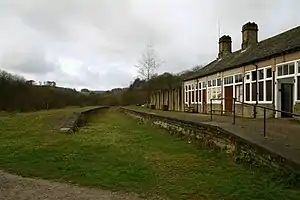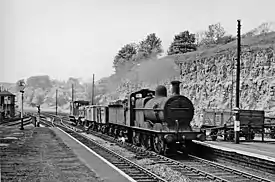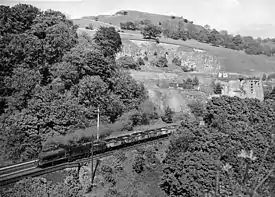Millers Dale railway station
Millers Dale railway station was situated in Millers Dale, near Tideswell, in the Peak District.
Millers Dale | |
|---|---|
 | |
| General information | |
| Location | High Peak England |
| Coordinates | 53.2563°N 1.7932°W |
| Grid reference | SK135733 |
| Platforms | 3 |
| Other information | |
| Status | Disused |
| History | |
| Pre-grouping | Midland Railway |
| Post-grouping | London, Midland and Scottish Railway |
| Key dates | |
| 1 June 1863 | Station opened |
| 1 May 1889 | renamed Millers Dale for Tideswell |
| 14 June 1965 | renamed Millers Dale |
| 6 March 1967 | Station closed[1] |
| Monsal Trail | |||||||||||||||||||||||||||||||||||||||||||||||||||||||||||||||||||||||||||||||||||||||||||||||||||||||||||||||||||||||
|---|---|---|---|---|---|---|---|---|---|---|---|---|---|---|---|---|---|---|---|---|---|---|---|---|---|---|---|---|---|---|---|---|---|---|---|---|---|---|---|---|---|---|---|---|---|---|---|---|---|---|---|---|---|---|---|---|---|---|---|---|---|---|---|---|---|---|---|---|---|---|---|---|---|---|---|---|---|---|---|---|---|---|---|---|---|---|---|---|---|---|---|---|---|---|---|---|---|---|---|---|---|---|---|---|---|---|---|---|---|---|---|---|---|---|---|---|---|---|---|
| |||||||||||||||||||||||||||||||||||||||||||||||||||||||||||||||||||||||||||||||||||||||||||||||||||||||||||||||||||||||
History
It was built in 1863 by the Midland Railway on its extension of the Manchester, Buxton, Matlock and Midlands Junction Railway from Rowsley.
It served an important junction where passengers for Buxton joined or left the trains between London and Manchester. It was originally to be called "Blackwell Mill" but, in the end, was named "Millers Dale for Tideswell". For such a rural location, it was unusually large; indeed, it was one of the largest stations on the line and was one of the few stations in England to have a post office on the platform. Millers Dale also sent dairy, agricultural and quarried products from the surrounding areas to the major cities. While also serving local towns and villages (notably Tideswell, Taddington and Wormhill), much of its activity was concerned with the connecting service to and from Buxton. Traffic for Buxton actually followed the main line north for nearly two miles, before diverging at Millers Dale Junction, beside Blackwell Mill Halt.[4]
Changing at Millers Dale often involved a wait and the High Peak News of November 1900 referred to the station as "Patience Junction".[4] The station was later immortalised in the 1964 song "Slow Train" by Flanders and Swann.[5]
The station closed in 1967, but trains continued to pass through until 1968, when the line was closed.
Stationmasters
- T. Turner 1863 - 1864[6] (afterwards station master at Kibworth)
- W. Fry 1864 - 1865[6]
- W. Palmer from 1865[6] (formerly station master at Brightside)
- H. Lewis until 1872[7] (afterwards station master at Ripple)
- W. Whitmore from 1872[7] - 1898[8]
- Joseph Henry Clarke 1898 - 1904[9] (afterwards station master at Matlock Bridge)
- W.E Coates 1905 - 1908[10] (afterwards station master at Kegworth)
- John Alderson 1908 - 1920[11] (afterwards station master at Skipton)
- A. Foster ca. 1937
Route
| Preceding station | Disused railways | Following station | ||
|---|---|---|---|---|
| Peak Forest Line and station closed |
Midland Railway New Mills-Millers Dale line |
Monsal Dale Line and station closed | ||
| Blackwell Mill Line and station closed |
Midland Railway Manchester, Buxton, Matlock and Midland Junction Railway |
To the north of the station, the line crossed the River Wye three times and ran through the 401 yards (367 m) and 94 yards (86 m) Chee Tunnels and the 121 yards (111 m) Rusher Hall tunnel, before reaching the New Mills line junction, 1.25 miles (2.01 km) from the station.[12]
Platforms


Built on a shelf carved out of the hillside, Millers Dale station originally had two platforms, but a bay platform was added in 1905 to accommodate Buxton trains, plus the down platform became an island platform to serve the extra tracks. The new loop and the second (northerly) viaduct were opened on 20 August 1905. The old viaduct was then closed, strengthened and reopened in April 1906.[12] Whilst the piers for the two viaducts are identical, the older viaduct is supported by an arch structure, whereas the later one is a box structure.
Part of the original Parliamentary Act approving the line considered the needs of invalids taking the waters at Buxton and so, for a while, 'through' carriages for Buxton were attached to, and detached from, expresses, thus alleviating the problem of changing trains. In addition, the two main platforms were connected by a subway.
Since closure
Since the railway was closed the station has become a car park, serving the Monsal Trail, although the main buildings remain, being partly used as public toilets. The hamlet of Millers Dale is still dominated by the two large disused viaducts over the Wye valley. The older of the viaducts became part of the Monsal Trail, an 8.5-mile (13.7 km) walking and cycle track.
The station building is due to reopen as a café and visitor centre in March 2019 after undergoing an extensive £230,000 restoration, providing additional services to users of Monsal Trail.[13]
See also
References
- Butt, R.V.J., (1995) The Directory of Railway Stations, Yeovil: Patrick Stephens
- "The Monsal Trail". A Taste of the Peak District. Retrieved 10 April 2020.
- Bickerdike, Graeme (June 2009). "The story of structures of the Monsal Trail: A Week in the Peak". Retrieved 10 April 2020.
- Railways of the Peak District. Blakemore & Mosley. 2003. ISBN 1-902827-09-0.
- Lyrics to "Slow Train" Archived 13 April 2013 at the Wayback Machine
- "1859-1866". Midland Railway Miscellaneous Depts: 203. 1914. Retrieved 30 December 2021.
- "1871-1879 Coaching". Midland Railway Operating, Traffic and Coaching Depts: 249. 1871. Retrieved 30 December 2021.
- "Retirement of the Miller's Dale Station Master". Derby Mercury. England. 3 August 1898. Retrieved 30 December 2021 – via British Newspaper Archive.
- "Presentation to Matlock Station-Master". Sheffield Daily Telegraph. England. 8 April 1904. Retrieved 30 December 2021 – via British Newspaper Archive.
- "District Items". Sheffield Evening Telegraph. England. 5 September 1908. Retrieved 30 December 2021 – via British Newspaper Archive.
- "Derby and Derbyshire and Elsewhere". Derbyshire Advertiser and Journal. England. 5 March 1920. Retrieved 30 December 2021 – via British Newspaper Archive.
- Railway Magazine October 1963 p. 680
- Former Peak District station to reopen soon as café and visitor centre Retrieved 2019-01-10.
External links
| Wikimedia Commons has media related to Millers Dale railway station. |